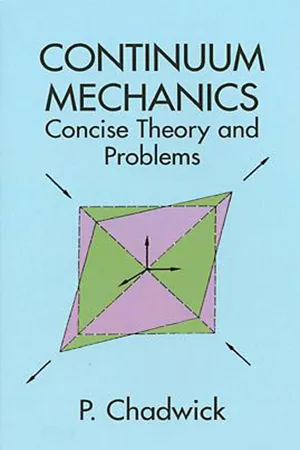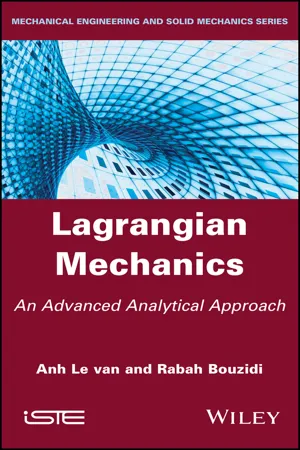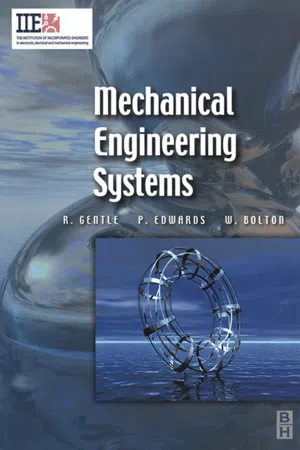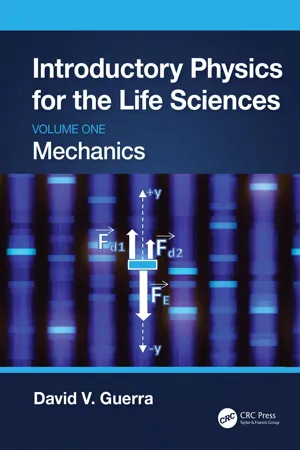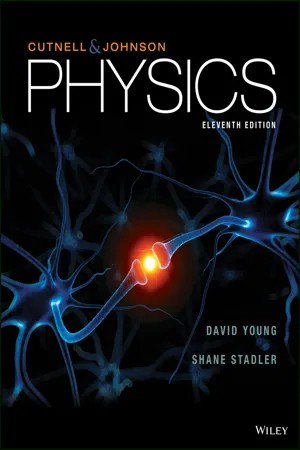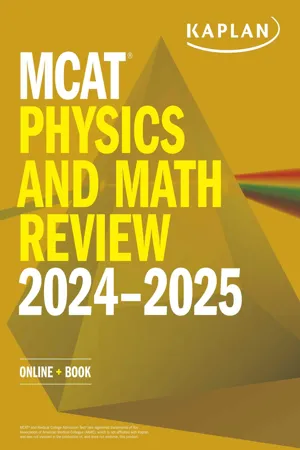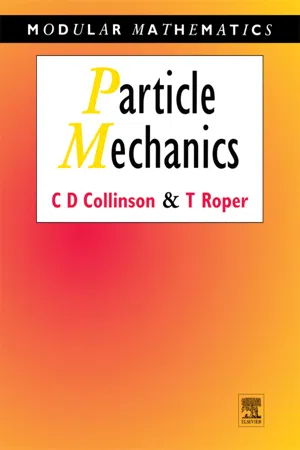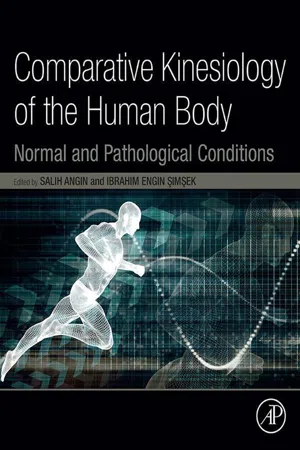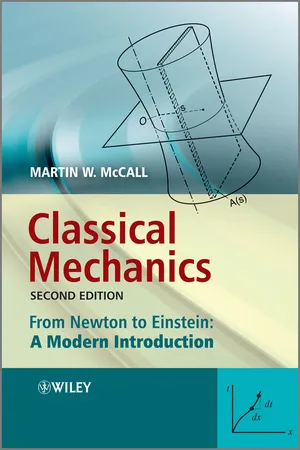Physics
Kinematics Physics
Kinematics in physics is the study of motion, focusing on the position, velocity, and acceleration of objects without considering the forces causing the motion. It involves analyzing the motion of objects using mathematical equations and graphs to describe their movement. Kinematics provides a foundation for understanding more complex concepts in physics, such as dynamics and energy.
Written by Perlego with AI-assistance
Related key terms
12 Key excerpts on "Kinematics Physics"
- eBook - ePub
Continuum Mechanics
Concise Theory and Problems
- P. Chadwick(Author)
- 2012(Publication Date)
- Dover Publications(Publisher)
Chapter 2BASIC KINEMATICSKinematics is the study of motion per se, regardless of the forces causing it. The primitive concepts concerned are position, time and body, the latter abstracting into mathematical terms intuitive ideas about aggregations of matter capable of motion and deformation. In the first three sections of this chapter we develop the simple kinematic notions involved in the formulation of the field equations of continuum mechanics. The more elaborate kinematic considerations which are basic to the theoretical mechanics of elastic materials and viscous fluids are then introduced in Sections 4 to 6 .1BODIES, CONFIGURATIONS AND MOTIONSA body is a set whose elements can be put into bijective correspondence with the points of a region B of a Euclidean point space . The elements of are called particles1 and B is referred to as a configuration of ; the point in B to which a given particle of corresponds is said to be occupied by that particle. If denotes a representative particle of and x the position relative to an origin o of the point x occupied by in B, the preceding statement implies the existence of a function2 θ: → B0 and its inverse Θ: B0 → such thatIn a motion of a body the configuration changes with time. Let t be a real variable, denoting time, and I an interval (not necessarily bounded) of the reals . If, with each value of t in I, there is associated a unique configuration Bt of a body , the family of configurations {Bt : t ∈ I} is called a motion of . This definition entails the existence of functions ϕ: × I → (Bt )0 and Φ: {(x, t): t ∈ I, x ∈ (Bt )0 } → such thatIn a motion of a typical particle occupies a succession of points which together form a curve in . This curve is called the path of and is given parametrically by equation (2) 1 The velocity and the acceleration of are defined as the rates of change with time of position and velocity respectively as - eBook - ePub
- D. Gordon E. Robertson, Graham E. Caldwell, Joseph Hamill, Gary Kamen, Saunders Whittlesey(Authors)
- 2013(Publication Date)
- Human Kinetics(Publisher)
PART IKINEMATICSKinematics is the study of motion without regard to causes. Studying human motion in the past was a time-consuming, laborious, and expensive task because cinematography was employed and manual methods were needed to extract the trajectories of body parts from the film. Advances in technology have automated much of the processes of capturing motion data electronically and then extracting the two- or three-dimensional trajectories. Such technology is now commonplace in the motion picture industry, but biomechanists use additional software to obtain time derivatives of the various trajectories or combine the trajectories to reconstruct the motions of body segments and joints so that differences in motion patterns can be readily identified. Kinematics is also the first step to analyses by inverse dynamics (covered in part II ) that estimate the causes of the motion. In this part, chapter 1 outlines how to record two-dimensional kinematics electronically, photographically, and videographically and how to extract digital data from the recordings. Chapter 2 outlines the additional mathematics and processing needed for three-dimensional kinematics. Note that chapter 12 outlines data smoothing techniques that are also important to the valid processing of kinematics, particularly accelerations. Several of the appendixes also have information concerning electronics (appendix C ) and mathematical principles (appendixes D and E) that are required for data collection and analysis in kinematics. Note that text in boldface is a concept described in the glossary at the end of the book.Passage contains an image
Chapter 1Planar KinematicsD. Gordon E. Robertson and Graham E. CaldwellK inematics - eBook - ePub
Lagrangian Mechanics
An Advanced Analytical Approach
- Anh Le Van, Rabah Bouzidi(Authors)
- 2019(Publication Date)
- Wiley-ISTE(Publisher)
1 KinematicsMechanics, the science that studies the motion of bodies, generally comprises three parts: (i) kinematics, where motions are described regardless of the causes that provoked the motions; (ii) kinetics, where we combine kinematics with the concept of mass; and (iii) dynamics, where we add the concept of the forces acting on the body.This chapter will focus on kinematics and will review the essential concepts of classical mechanics: the observer or reference frame, time, space, as well as velocity and acceleration. Chapter 2 will focus on the parameterization, the parameterized kinematics as well as the parameterized kinetic energy, concepts that are essential for analytical mechanics. Forces will be studied in Chapter 3 .Apart from the above-mentioned real quantities, analytical mechanics also brings in virtual quantities (virtual velocity, virtual power), which will be discussed in Chapters 4 and 5 .1.1. Observer – Reference frame
We admit the existence of observers, real or fictional, located in areas that may or may not be accessible to humans. An observer is denoted by , the integer index i making it possible to distinguish from the different observers.The observer needs an instrument called a clock to note the start, end or duration of an event (the notions of event and time will be seen hereafter).They also need an observation instrument placed on a support called a reference solid, to observe mechanical systems and their positions in physical space and at each instant (Figure 1.1 ; the notions of mechanical system and position will be seen in section 1.3 ).Figure 1.1. Reference solid and observation instrumentDefinition. A reference frame is an observer equipped with a clock and an observation instrument placed on a reference solid. The reference frame associated with the observer will be denoted as Ri .Thus, the term “reference frame” is almost synonymous with “observer”, while having a slightly more precise sense. Furthermore, the term “observer” makes one think of the presence of a human in the study, whereas “reference frame” is more impersonal. For notational convenience, the notation Ri is preferred to - eBook - ePub
- Richard Gentle, Peter Edwards, William Bolton(Authors)
- 2001(Publication Date)
- Newnes(Publisher)
4Dynamics
SummaryThis chapter deals with movement. In the first part the movement is considered without taking into account any forces. This is a subject called kinematics and it is important for analysing the motion of vehicles, missiles and engineering components which move backwards and forwards, by dealing with displacement, speed, velocity and acceleration. These quantities are defined when we look at uniform motion in a straight line. This subject is extended to look at the particular case of motion under the action of gravity, including trajectories. This chapter also looks at how the equations of motion in a straight line can be adapted to angular motion. Finally in the first half the subject of relative velocity is covered as this is very useful in understanding the movement of the individual components in rotating machinery.In the second part of this chapter we consider the situation where there is a resultant force or moment on a body and so it starts to move or rotate. This topic is known as dynamics and the situation is described by Newton’s laws of motion. Once moving forces are involved, we need to look at the mechanical work that is being performed and so the chapter goes on to describe work, power and efficiency. Newton’s original work in this area of dynamics was concerned with something called momentum and so this idea is also pursued here, covering the principle of conservation of momentum. The chapter extends Newton’s laws and the principle of conservation of momentum to rotary motion, and includes a brief description of d’Alembert’s principle which allows a dynamic problem to be converted into a static problem. - David V. Guerra(Author)
- 2023(Publication Date)
- CRC Press(Publisher)
7 Kinematics
DOI: 10.1201/9781003308065-77.1 Introduction
Thus far in this volume, the motion of the objects analyzed was simply at rest or in the case of the magnetic force, moving at a constant speed at one instant of time. The techniques applied to analyze a situation were centered around the analysis of vectors. A diagram was produced, vector components were found, an expression was applied, and solutions were found.At this point in the volume, the topic of kinematics, which is the terminology and the analysis employed to study the motion of objects, is introduced. The solutions to the problems in this chapter are associated with the definitions of different types of motion and not focused on the components of force vectors. Therefore, the pattern of analysis established in the previous chapters is not applied in this chapter, but it will return in the next chapter after the terminology and techniques of kinematics are studied.- Chapter question: A family makes an 800 km trip, strictly eastward, as described in Figure 7.1 . The family travels the first half of the trip distance at 80 km/h, quickly speeds up, and then maintains a speed of 100 km/h for the second half of the trip distance. For this entire trip, is the average speed 90 km/h? This question will be answered at the end of the chapter using the formal mathematical study of motion, called Kinematics, which is the topic of this chapter.
FIGURE 7.1 Family trip.
7.2 Kinematic Definitions
Kinematics, first developed by Galileo, is the formal study of the motion of objects using diagrams, graphs, and equations. In the previous chapters, the analysis employed assumed the objects were either at rest or moving at a constant speed. Situations under these conditions are known as a static, because the forces are balanced. When the forces become unbalanced, accelerated motion results. In this chapter, the terminology used to describe all types of motion is formalized in preparation for subsequent chapters in which the resulting motion of unbalanced force will be studied. This chapter will start with a definition of displacement and then explore velocity and acceleration in both graphical and analytical formats. It is important to realize that the problem-solving techniques employed in this chapter are different than those used in the previous and subsequent chapters, and this is only a brief aside to introduce the terminology and practices of kinematics.- eBook - ePub
- John D. Cutnell, Kenneth W. Johnson, David Young, Shane Stadler(Authors)
- 2018(Publication Date)
- Wiley(Publisher)
CHAPTER 2Kinematics in One DimensionThe pilots in the United States Navy's Blue Angels can perform high-speed maneuvers in perfect unison. They do so by controlling the displacement, velocity, and acceleration of their jet aircraft. These three concepts and the relationships among them are the focus of this chapter.LEARNING OBJECTIVES
After reading this module, you should be able to…- 2.1 Define one-dimensional displacement.
- 2.2 Discriminate between speed and velocity.
- 2.3 Define one-dimensional acceleration.
- 2.4 Use one-dimensional kinematic equations to predict future or past values of variables.
- 2.5 Solve one-dimensional kinematic problems.
- 2.6 Solve one-dimensional free-fall problems.
- 2.7 Predict kinematic quantities using graphical analysis.
2.1 Displacement
There are two aspects to any motion. In a purely descriptive sense, there is the movement itself. Is it rapid or slow, for instance? Then, there is the issue of what causes the motion or what changes it, which requires that forces be considered. Kinematics deals with the concepts that are needed to describe motion, without any reference to forces. The present chapter discusses these concepts as they apply to motion in one dimension, and the next chapter treats two-dimensional motion. Dynamics deals with the effect that forces have on motion, a topic that is considered in Chapter 4. Together, kinematics and dynamics form the branch of physics known as mechanics . We turn now to the first of the kinematics concepts to be discussed, which is displacement.To describe the motion of an object, we must be able to specify the location of the object at all times, and Figure 2.1 shows how to do this for one-dimensional motion. In this drawing, the initial position of a car is indicated by the vector labeled. The length ofx →0is the distance of the car from an arbitrarily chosen origin. At a later time the car has moved to a new position, which is indicated by the vectorx →0x →. The displacement of the carΔ(read as “delta x” or “the change in x”) is a vector drawn from the initial position to the final position. Displacement is a vector quantity in the sense discussed in Section 1.5 , for it conveys both a magnitude (the distance between the initial and final positions) and a direction. The displacement can be related tox →andx →0x → - eBook - ePub
Doing Physics with Scientific Notebook
A Problem Solving Approach
- Joseph Gallant(Author)
- 2012(Publication Date)
- Wiley(Publisher)
Chapter 2One-Dimensional Kinematics
We start Doing Physics with SNB in the branch of physics known as Classical Mechanics. Our study of Classical Mechanics begins with one-dimensional kinematics, the description of motion in a straight line. This includes horizontal motion to the right or left and vertical motion straight up or down. This description will tell us where an object is, where it is going, and how much time it took to get there.Constant Acceleration
Studying motion with a constant acceleration is a good place to start. We can describe this motion completely without using calculus. Let’s start with some definitions and important distinctions, and then we’ll solve some one-dimensional problems.Displacement and Position
To describe an object’s motion, we need to establish a coordinate system so we can specify location. For 1-dimensional motion the coordinate system is just the x-axis with the origin at x = 0 and positive values to the right. The object’s position, specified by its x-coordinate, tells us how far from the origin it is and in which direction.The displacement is the object’s change in position.(2.1)This difference between the object’s final and initial position tells us how far from its original position it ends. A positive displacement means the object ends to the right of x0 and a negative displacement means the object ends to the left of x0 . For a round trip, the initial and final positions are equal and the displacement is zero. The SI unit for both position and displacement is the meter (m).Note The use of the upper case Greek letter delta (“Δ”) to mean “change in” is standard mathematical notation, but it has no special significance in SNB. In a calculation, SNB interprets the expression Δf as Δ x f, the product of two variables.Even though they have the same unit, displacement and distance are different. Suppose you start 2 meters from the origin, walk 9 meters to the right, turn around and walk 5 meters back toward the origin. Your initial position was x0 = 2 m and your final position is x = 6m, so your displacement is Δx - No longer available |Learn more
MCAT Physics and Math Review 2024-2025
Online + Book
- (Author)
- 2023(Publication Date)
- Kaplan Test Prep(Publisher)
CHAPTER 1KINEMATICS AND DYNAMICS
In This Chapter
Fundamental Measurements1.1 UnitsVector Addition Vector Subtraction Multiplying Vectors by Scalars Multiplying Vectors by Other Vectors1.2 Vectors and ScalarsDisplacement Velocity1.3 Displacement and VelocityForces Mass and Weight Acceleration1.4 Forces and AccelerationFirst Law Second Law Third Law1.5 Newton’s LawsLinear Motion Projectile Motion Inclined Planes Circular Motion1.6 Motion with Constant AccelerationFree Body Diagrams Translational Equilibrium Rotational Equilibrium1.7 Mechanical EquilibriumConcept SummaryCHAPTER PROFILE
The content in this chapter should be relevant to about 6% of all questions about physics on the MCAT. This chapter covers material from the following AAMC content category:4A: Translational motion, forces, work, energy, and equilibrium in living systemsIntroduction
A professor once said: Biology is chemistry. Chemistry is physics. Physics is life. Not surprisingly, this was the claim of a physics professor.Walking into MCAT preparation, many students think of physics as the least applicable science to medicine, reflecting on calculus-heavy premedical classes. But even in the medical field, physics is all around us. When we treat patients at a rehab hospital, we often talk about motion, forces, and bone strength. An ophthalmologist may draw diagrams to help students better understand myopia and hyperopia. When we talk about mitochondria functioning as the batteries of the cell, we mean that fairly literally.This first chapter reviews the three systems of units encountered on the MCAT: MKS (meter–kilogram–second), CGS (centimeter–gram–second), and SI (International System of Units). We’ll take a few moments to review the geometry of physics questions, especially vector mathematics. Next, we’ll move into true physics content as we consider kinematics—the equations that deal with the motion of objects—and Newtonian mechanics and dynamics—the study of forces and their effects. - eBook - ePub
- Chris Collinson, Tom Roper(Authors)
- 1995(Publication Date)
- Butterworth-Heinemann(Publisher)
Chapter 2 are generalized to the motion of a particle moving in space. A vectorial approach is used throughout, coordinates, when used, being adapted to the problem being discussed. The importance of the choice of frame of reference used to describe the motion of a given particle is stressed and the role played by Newton’s first law of motion in the choice of the frame of reference is discussed. Three different types of conservation laws are derived. These are important in that they provide first integrals of the equation of motion which can be written down without the need for carrying out actual integrations. Newton’s third law of motion is stated in both a weak and strong form. Much of this Chapter is concerned with development of the theory and the opportunity for tackling exercises is therefore somewhat restricted.4.1 Kinematics of a Particle Moving in Space
Consider a particle moving in space. The definitions and results which we are about to discuss are generalizations of those discussed in Section 2.1 for a particle P moving on a straight line. In Section 2.1 the position of P was specified, relative to a given origin O lying on the line of motion, by a directed number x , the displacement of P relative to O. You will have noticed the fact that if the line of motion is chosen as the x-axis of a cartesian coordinate system with origin O , then the displacement of P relative to O is just the × coordinate of P. An obvious generalization for a particle P moving in space would be to specify the position of P relative to a given origin by the cartesian coordinates (x, y, z) of P relative to a given set of axes passing through O. In order to simplify later calculations we confine attention here to right handed rectangular cartesian coordinates for which the axes are mutually perpendicular and orientated with O z in the direction of the thumb of the right hand when the curled fingers of that hand are scooped from O x to O y, as in Fig 4.1 . The axes are said to form a frame of reference or frame against which the motion of the particle is viewed.Fig 4.1 Right handed rectangular cartesian axes.Cartesian coordinates are not always the most convenient coordinates to use when discussing particular motions. For example, it is far easier to use plane polar coordinates and the equation r = a to specify motion on a circle of radius a centred at O than to use cartesian coordinates and the equation x 2 + y 2 = a 2. For this reason we prefer to adopt a vectorial approach when discussing the general motion of a particle P in space. In this approach the position of P is specified by the displacement vector relative to a given origin O. This is an alternative generalization of the displacement x ; for straight line motion the displacement is indeed a vector, its sign indicating the direction of the vector. The displacement vector is called theposition vector of P relative to Oand is denoted by r . This vectorial approach is closely related to the coordinate approach. Taking a right handed set of orthonormal basis vectors and , the components of the position vector r of P relative to O are just the cartesian coordinates (x , y , z ) of P relative to axes drawn parallel to the basis vectors and passing through O - eBook - ePub
- Michael M. Mansfield, Colm O'Sullivan(Authors)
- 2020(Publication Date)
- Wiley(Publisher)
4 Motion in two and three dimensionsAIMS
- to show how, in two and three dimensions, physical quantities can be represented by mathematical entities called vectors
- to rewrite the laws of dynamics in vector form
- to study how the laws of dynamics may be applied to bodies which are constrained to move on specific paths in two and three dimensions
- to describe how the effects of friction may be included in the analysis of dynamical problems
- to study the motion of bodies which are moving on circular paths
4.1 Vector physical quantities
The material universe is a three‐dimensional world. In our investigation of the laws of motion in Chapter 3 , however, we considered only one‐dimensional motion, that is situations in which a body moves on a straight line and in which all forces applied to the body are directed along this line of motion. If a force is applied to a body in a direction other than the direction of motion the body will no longer continue to move along this line. In general, the body will travel on some path in three‐dimensional space, the detail of the trajectory depending on the magnitude and direction of the applied force at every instant. Equation (3.3) as it stands is not sufficiently general to deal with such situations, for example the motion of a pendulum bob (Figure 4.1 ) or the motion of a planet around the Sun (Figure 4.2 ). Newton's second law needs to be generalised from the simple one‐dimensional form discussed in Chapter 3 .A pendulum comprising a mass attached to the end of a string; the mass can move on a path such that the distance from the fixed end of the string remains constant.Figure 4.1A similar problem arises if two or more forces act on a body simultaneously, for example when a number of tugs are manoeuvring a large ship (Figure 4.3 - eBook - ePub
Comparative Kinesiology of the Human Body
Normal and Pathological Conditions
- Salih Angin, Ibrahim Simsek(Authors)
- 2020(Publication Date)
- Academic Press(Publisher)
Fig. 2.9 shows the illustration of three fundamental arthrokinematic motions using the motions of a car tire. Gliding is a linear motion in which the movement of one joint surface is parallel to the plane of the adjacent joint surface, such as car tire is gliding (skidding) along the ground. Rolling is an angular motion in which each point on a surface comes into contact new point on the other joint surface, such as car tire is rolling along the ground. Spinning is an angular motion in which the rotations of the movable joint surface on the fixed adjacent surface, such in spinning of car tire without changing location.Figure 2.9 Arthrokinematic motions: roll, spin, glide, analogy of arthrokinematic motions can be made to a car tire. (A) Tire that is rolling along the ground. (B) Tire that is spinning without changing location. (C) Tire that is gliding/sliding (skidding) along the ground.Kinetics
Force can be thought of as a push or pull acting on an object. Pushing on a stalled car may or may not move the car, depending on the direction and strength of the push, and the force of friction between your feet and the ground. Kinetics is the subdivision of mechanics that is concerned with the forces acting on a system such as any object, or human body. The kinetic movement analysis describes the causes of motion and investigates the forces causing a movement. If we take the example of volleyball sport, the possible kinetic variables during the activity are the forces between the ball and the hands, and the forces between the feet and the ground. Kinetic analysis is more difficult than the kinematic movement analysis because forces cannot be seen. There is no way of accurately investigating the force unless it can be measured with recording devices, because the force cannot observe visually.Kinetic information is essential for improving human motion and performance. Kinetic analysis also identifies the important parts of a skill in terms of movement production. For example, a skill that involves vertical jumping is integral to successful spiking in the sport of volleyball. Therefore, the knowing that the amount of hip extensor, knee extensor, and the plantar flexor actions during vertical jumping is important for improving spiking performance in volleyball players. After kinetic analyses, you can answer following question: What is the best technique for maximizing a vertical jump in volleyball players and which muscles are especially important rehabilitation? - eBook - ePub
Classical Mechanics
From Newton to Einstein: A Modern Introduction
- Martin W. McCall(Author)
- 2011(Publication Date)
- Wiley(Publisher)
Newton’s laws may be applied in all inertial frames, but the trajectories will look different from one inertial frame to the next. We can often use this latitude of choice of frame to our advantage in problems. Many situations in the real world of three spatial dimensions can be reduced to motion in one dimension. Throwing an object at some angle to the ground results in a parabolic (i.e. 2-D) trajectory. However, the horizontal velocity is constant, and so viewed from a frame of reference which moves with this velocity the motion is purely vertical (i.e. 1-D). By studying one-dimensional motion we are actually developing the tools to solve many higher dimensional problems which can be mapped back to one-dimensional motion. When tackling a mechanics problem, the first question to consider is what is the simplest frame in which to view the situation? 2.2 The Concept of a Particle The fact that we are considering one-dimensional motion means that the location of any body, and more particularly the location through which any force acting on the body passes, is precisely defined. We simply say that the force acts at the point where the body is located. However, since we will want to apply our ideas to more complex situations, it is worth introducing the idealisation of a ‘particle’. A particle is the idealisation that an extended body’s mass is concentrated at a particular point. To what extent it is appropriate to regard an extended body as a ‘particle’ depends on the precision required by the problem at hand. Thus, for analysing the trajectory of a cricket ball as it soars beyond the boundary, the particle approximation is adequate, but for analysing the movement off the wicket induced by a bowler’s leg break, the ball’s ‘extended’ motion, or spin, must be included and the particle approximation is inappropriate
Index pages curate the most relevant extracts from our library of academic textbooks. They’ve been created using an in-house natural language model (NLM), each adding context and meaning to key research topics.
